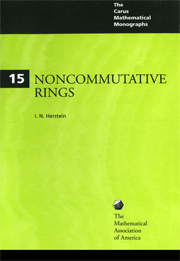PREFACE
Summary
This book is not intended as a treatise on ring theory. Instead, the intent here is to present a certain cross-section of ideas, techniques and results that will give the reader some inkling of what is going on and what has gone on in that part of algebra which concerns itself with noncommutative rings. There are many portions of great importance in the theory which are not touched upon or which are merely mentioned in passing. On the other hand there is a rather detailed treatment given to some aspects of the subject.
While the account given here is not completely self-contained, to follow it does not require a great deal beyond a good first course in algebra. Perhaps I should spell out what I would expect in such a course. To begin with one should have been introduced to some of the basic structures of algebra—groups, rings, fields, vector spaces—and to have seen some of the basic theorems about them. One would want a good familiarity with homomorphisms, the early homomorphism theorems, quotient structures and the like. One should have learned with some thoroughness linear algebra—the fundamental theorems about linear transformations on a vector space. This type of material can be found in many books, for instance, Birkhoff and MacLane A Survey of Modern Algebra or my book Topics in Algebra.
- Type
- Chapter
- Information
- Noncommutative Rings , pp. ix - xPublisher: Mathematical Association of AmericaPrint publication year: 1968



